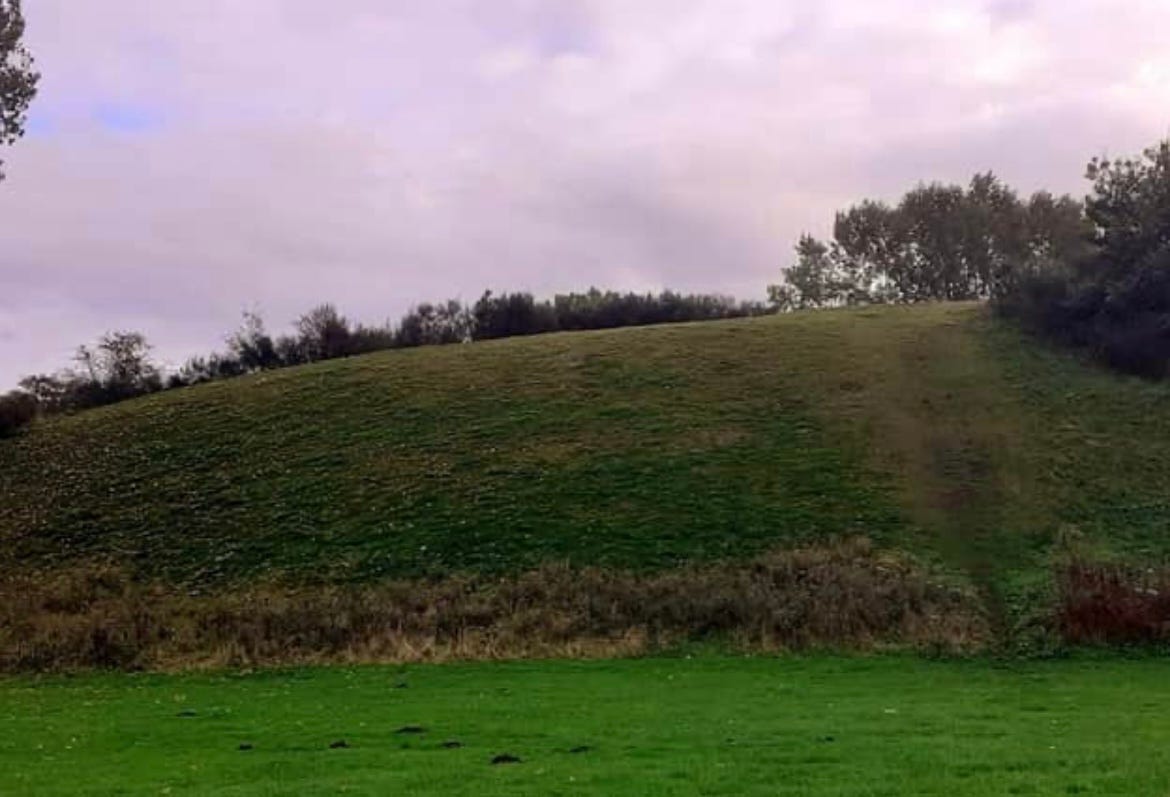The Lambton Worm
A drawing, a couple of photographs and some words...
Whisht! lads, haad ya gobs,
Aa’ll tell ye aall an aaful story,
Whisht! lads, haad ya gobs,
An aa’ll tell ye ‘boot the worm.
The Chorus of 'The Lambton Worm'
Few people in northeast England will not have heard of the legend of the Lambton Worm. Where the people of Tyneside have the anthem, ‘Blaydon Races’, Wearside has a song based on the ancient folk tale. And I'll start by clarifying the term worm, an archaic name for a dragon or sea serpent derived from the Germanic 'wyrm'.
Lambton refers to the village of Lambton, which lies close to the City of Sunderland, and the family of that name, of which the first record is of John Lambton, Lord of Lambton, who lived about 1150. Lambton is believed to be Anglo-Saxon, meaning farm or village where lambs were raised, i.e. a sheep farming area.
The Lambtons remain an important family in County Durham today, in the past, owning Lambton Castle (some British readers might remember the BBC series 'The Paradise' filmed in the castle) and having much political influence in Britain, with several prominent figures, including military leaders and politicians. While there is no longer a Lord Lambton, the Lambton family's title is Earl of Durham. A title that was created in 1833 for another John (confusingly, John seems to have been an extremely popular first name in the Lambton family) Lambton, known at the time as "Radical Jack", as he played a leading role in the passing of the Reform Act in 1832 that gave the vote to a broader section of the British population. He was also the author of the 'Report on the Affairs of British North America', known in Canada as the 'Durham Report', which influenced the political structure of Canada.
More recently, the Lambton family member I remember was Antony, a controversial figure who resigned as a Conservative MP in 1973 after a scandal involving sex workers and illegal drugs. Though he never inherited the title of Earl of Durham, he was often referred to informally as "Lord Lambton".
The earliest written record of the legend of the Lambton Worm was from the historian William Hutchinson, who wrote in 1785: "Fatfield Staithes ... Near this place is an eminence called the Worm Hill, which tradition says was once possessed by an enormous serpent, that wound its horrid body round the base; that it destroyed many provisions, and used to infest the Lambton estate, till some hero in that family engaged it, cased in armour set with razors, and when it would have crushed the combatant by enfolding him, sustaining a thousand wounds, fell at last by his falchion (a type of sword)." But the story of the Lambton Worm is far older
No one knows when the tale of the Worm was first told, but it is believed that the story, with its elements of medieval chivalry, curses, and monstrous beasts, has been an oral tale for centuries. It shares similarities with dragon-slaying myths across Europe (think Beowulf and George and the Dragon, etc.).
According to legend, a young John Lambton, heir to the Lambton estate, was a rebellious and mischievous boy. One Sunday, while his family and all the other Lambton estate residents were attending church, he went fishing in the River Wear that flowed near the Lambton estate. After hours of fishing, his hook caught something powerful and quick. He toiled for what seemed an age and finally pulled his prize from the river only to discover not a fish but a tiny black worm-like creature that twisted and coiled with great power. The beast had the head of a salamander and needle-sharp teeth. Cursing, John wondered what to do with the creature when he heard the voice of an old man behind him who warned John not to throw the creature back into the river. So, John put the beast into his catch basket. But while walking home, a feeling of unease swept over him, and he threw his catch into an old well.
The years passed, and John went off to the Crusades as a Knight of Rhodes, fighting far from home in penance for his profligate youth. While John was away, the Worm strengthened in its deep dark well.
One night, the fully matured Worm emerged from the well. It coiled itself around a hill (see later - exactly which hill is still debated today). As the news spread throughout the estate, those brave enough went as close as they dared to glimpse the creature, which had no legs or wings but a thick, muscled body that rippled as it moved. Its head was large, and its gaping mouth bristled with what were now razor-sharp teeth.
For a brief time, the Worm did nothing, but this lull was short-lived. Soon, the beast became hungry, and people started to notice livestock and people going missing. The Worm became bolder and bolder, eating cattle, sheep, and even the occasional child who came too near its hill. Some brave villagers tried to kill the beast but were crushed and drowned in the river or torn to pieces by its fangs.
After seven years had passed, John returned from the Crusades as a changed man and a powerful and seasoned knight. When he heard of the plight of his estate, he suspected the Worm was the same one he had caught years ago. John saw it as his duty to kill the now dangerous creature so that people could live peacefully. He tried to kill the Worm several times but failed to do so. The Worm, by this point, was too mighty, and no matter how gravely John injured it, the Worm would always escape and always recover. As skilled a Knight as he was, John needed help.
So, John sought the advice of a wise local woman, who confirmed that he was responsible for the Worm and the only one who could kill it. She told John to have a blacksmith make a suit of armour wrought with razor-sharp double-head spikes studded throughout its surface. Then he was to go to the Worm's hill, let the Worm wrap itself around him and allow the spikes of his armour do their job. But she added that after slaying the Worm, John must kill the first living thing he saw afterwards, or his family would suffer a curse for nine generations that none would die peacefully in their bed.
John listened to the advice and swore an oath to complete his task. He had the armour made to instruction, and with the wise woman's condition in mind and fearing a member of his family would be the first living thing he saw, John arranged that once he had slain the beast, he would sound his hunting horn as a sign that his father should release one of the hunting dogs for John to kill. He then went off to battle the Worm that slithered off its hill, trying to crush him by wrapping around him, but as the wise woman predicted, as it did so, the spikes cut through the Worm's body, shredding its soft flesh. Eventually, the Worm grew so weak that John could despatch it with one heavy sword blow to its head, and the current of the River Wear carried away the pieces of Worm.
John then blew three blasts on his hunting horn to signal his success. But in the heat of the moment, his father ran to congratulate him rather than release the dog. Unable to kill his father, John was faced with a tragic dilemma. He chose to break the oath, which would haunt the Lambton family for generations.
A good story and history doesn't record the demise of all of the early Lambtons, although it is known that in 1583, Robert Lambton drowned at Newrig; Colonel William Lambton was killed at the Battle of Marston Moor in 1644, and Henry Lambton died while travelling in his carriage on Lambton Bridge in 1761. It is said that Henry's brother, a General, kept a horse whip by his bedside to ward off violent assaults should the Worm ever appear again. He died in his bed at an old age.
Much of the credit for modern awareness of the Lambton Worm comes from the popular Victorian folk song written in 1867 by C M Leumane. The song proved very popular but did cause some controversy about the whereabouts of the hill around which the Worm wound itself.
In the 1785 story, William Hutchinson wrote of a 'worm hill' near a former coal mining village called Fatfield. A hill with such a name is in that area. However, in the later song, C M Leumane introduced a twist, casting doubt on the hill's location and adding another layer of mystery to the legend.
“..This feorful worm wad often feed
On calves an’ lambs an’ sheep
An’ swally little bairns alive
When they laid doon to sleep.
An’ when he’d eaten aall he cud
An’ he had had his fill,
He craaled away an’ lapped his tail
Seven times roond Pensher Hill…”
The 'Pensher' (the northeast dialect pronunciation of Penshaw) Hill is located near the once-coal mining village of Penshaw, about a mile from Fatfield as the crow flies. Standing at four hundred and fifty feet (circa one hundred and ninety metres), Penshaw Hill dwarfs the more modest Worm Hill of fifty-two feet (circa eighteen metres). Atop Penshaw Hill also sits the Penshaw Monument.
The debate between Fatfield and Penshaw as to whose is the 'true' Worm Hill continues to his day. And the claim by Penshaw probably comes from the Monument I mentioned. A folly built from local sandstone, some twenty years before the writing of the folk song, in honour of the prominent British politician John Lambton, the 1st Earl of Durham that I mentioned above. The monument was designed as a replica of the Temple of Hephaestus, a significant Greek deity associated with fire and metalworking, and it stands seventy feet (thirty metres) tall. Though it resembles a temple, it has no interior rooms or roof—it is an open-air structure. The monument was funded by public subscription, reflecting the widespread recognition of John Lambton in northern England.
Whatever the argument about the Worm, Penshaw Hill is the site of the only triple rampart, Iron Age hill fort known in North England. The spiral patterns or furrows suggested by the legend that the Worm formed by coiling around the hill could be the triple ramparts of the hill fort. Today, the National Trust manages the Monument, a popular landmark and walking destination. On certain days, visitors can climb to the Monument's top via a spiral staircase inside one of the columns to enjoy the panoramic views of Sunderland, Durham, and the River Wear.
Anyway, here's the song, sung in a toned-down northeast vernacular by none other than Bryan Ferry. Yes, that Bryan Ferry, the lead vocalist and songwriter for the art rock band Roxy Music, whose distinctive, suave style and smooth vocals made him one of the most influential figures in glam rock and new wave. Many people may not know that he was born in the town of Washington, the ancestral 'home' of the first President of the USA, in northeast England. Indeed, my sister went to Washington Grammar School with Bryan. He sings the Lambton Worm a bit stylised compared to the pacier version sung in clubs and pubs, but it is probably more understandable to the ears of those not in northeast England.





Interesting, Harry. I knew the song, but not all the background to it. Thanks!
Fascinating. Thanks, Harry